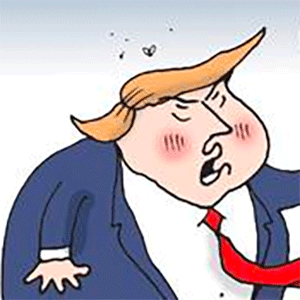Trump's demand Mexico stop migrants and drugs may never be met
Published in Political News
MEXICO CITY — It would take years, if ever, for Mexico to accomplish what incoming U.S. President Donald Trump is demanding to avoid tariffs: stemming the flow of migrants and drugs over the border.
That’s why Mexican President Claudia Sheinbaum’s efforts to avoid a full-blown trade war might be more about doing enough for both sides to claim success.
Even a quick phone call — two days after Trump threatened 25% tariffs against his southern neighbor — seemed to change the tone: Trump said on social media that the Mexican president agreed to “stop people from going to our Southern Border, effective immediately.”
Sheinbaum, meanwhile, assured her constituents that she touted to Trump Mexico’s existing approach to migration, which she stressed respects human rights, and that a new deal to collaborate would avoid new tariffs, without providing specifics.
The whole exchange was reminiscent of Trump’s first term, when he threatened to send troops to shut down the border and then-President Andres Manuel Lopez Obrador responded by sending the national guard to help apprehend migrants. The move had a limited immediate effect, but sent a strong image that proved enough to at least avert tariffs of up to 25% on all imports from Mexico.
Trump’s threats have a “dual objective,” said Palmira Tapia, a political scientist currently working for the government of the State of Mexico. The U.S. president-elect, she said, is simultaneously seeking to appeal to his constituents and strengthen his hand in talks on migration, drugs and trade.
Sheinbaum also faces two challenges: She now must find a way to appease Trump to avoid tariffs that could hit 11% of Mexico’s gross domestic product, while also avoiding the perception — at home, and in the White House — that she will easily bend to demands from up north.
“She’s talking to Trump, but she’s also talking to the Mexican public. It has to do with giving a dignified response before her voters, but at the same time trying to stop Trump,” said Catalina Perez Correa, a researcher at the Supreme Court’s Center for Constitutional Studies. “She’s saying, ‘I’m not going to let myself be stepped on by Trump.’ She’s saving face in front of the Mexican public.”
Migration reality
Mexico has long been a stomping ground for the U.S. when it comes to migration policy. It’s been tasked under successive U.S. presidents with beefing up its border security, increasing highway checkpoints and removing migrants from freight trains they often board.
Even though migration rose far beyond the 2019 levels in the years after Lopez Obrador’s show of militarizing the border, Mexico has remained an at-times willing partner, accepting most of the millions of migrants who were quickly turned away from the U.S. border during the pandemic.
But it hasn’t always been eager to help: The Biden administration often viewed AMLO, as the former president was known, as needing frequent reminders of its expectations for him on enforcement. In 2023, Biden Cabinet officials even visited AMLO in Mexico City just days after Christmas to urge him to do more as a record number of migrants reached the border.
Under pressure from the White House during the U.S. election, Mexico helped it decrease border crossings by 65% over an 11-month period starting in December 2023.
To do so, Mexican authorities have been detaining migrants in the north of the country and busing them south. There, they are forced to wait until they get an official appointment to apply for asylum in the U.S. — which can take months, if it ever happens at all. It’s all resulted in more than double the number of apprehensions of undocumented migrants between January and August compared with a year earlier, although Mexico has deported few.
Experts have said that’s creating a humanitarian crisis in some of the southern cities where migrants are shipped off to. It’s also ratcheting up tensions with some locals, who argue that there aren’t enough jobs or resources to accommodate the newcomers.
“What they’re doing now in Mexico is militarization of the border,” said Perez Correa.
To further reduce border crossings into the U.S., Mexico could either carry out mass deportations or offer more opportunities to migrants in its territory. Both scenarios seem unrealistic.
Simply increasing deportations would go against Lopez Obrador’s policy — which Sheinbaum inherited — of trying to address the problems in their origin countries that pushed them to leave, and it would be an expense for Mexico. After Sheinbaum’s call with Trump, she reiterated her government offers migrants options for international protection in its territory or “voluntary or assisted return” to their countries.
The second option doesn’t seem feasible either: Most people want to go to the U.S., where they expect to have higher-paying jobs, more family or community support, and greater safety than in Mexico.
Chemical diversions
Deaths related to fentanyl — the cheap, synthetic opioid — have reached epidemic levels in the U.S. That’s why reining in the flow of the drug was on Trump’s list of demands.
Should recent history be any indication, intervention is never simple. The U.S. arrest of a Mexican alleged drug leader has led to prolonged shootouts in recent months. And in any case, some academics argue simply confiscating more drugs means traffickers learn to produce more, to meet U.S. demand.
So far, Mexico has worked to improve its technical capabilities to detect illicit substances at its ports, especially precursor chemicals and fentanyl.
“The Navy has provided material and personnel to all ports for the fulfillment of these tasks, the personnel have the necessary training to be able to detect these substances,” said Captain Jose Barradas in an interview at the Manzanillo port, in the state of Colima. “All merchandise that arrives is prone to review under strict security protocols.”
Sheinbaum also picked former Mexico City police chief Omar Garcia Harfuch to lead a new national security strategy, a move that was read inside Mexico as a signal of her willingness to increase enforcement in areas where the previous administration had been more hands-off.
There’s more that could be done — but it would be hard. Trying to seize these substances at ports is insufficient because synthetic drugs tend to be very small, making them more difficult to detect than traditional drugs, said Victoria Dittmar, researcher at Insight Crime. Those who produce them often innovate with their recipes and use new chemicals that are not illegal.
“Mexico can open collaboration paths with the private sector, with the chemical industry, because they know perfectly well its supply chains and the vulnerable areas where there could be diversions,” she said. “This collaboration is essential.”
Mexico can also work to identify intermediaries that connect fentanyl producers with chemical suppliers abroad and in the country, people who work in certain companies and are authorized to divert these substances, according to Dittmar.
Still, “the main weakness is not putting demand reduction as a priority, to prevent overdose deaths,” Dittmar said. “It’s a shared responsibility. It’s not just the fault of Mexico, the U.S. or Canada, but it’s an issue that affects the entire North American region.”
A senior Mexican official said that the country’s actions to address drug trafficking have moved the nation in the direction of the fentanyl crackdown that Trump is demanding. The official cited a new law that will allow for coordinated intelligence efforts that is due to be implemented next year.
History repeats
It’s plausible that in the medium-term Trump will lower the intensity of his threats because a trade war would be the worst case scenario for both countries, said Tapia, the political scientist.
But until then, she said, “Sheinbaum is on trial as to how well she will do” relative to her predecessor, who had a respectful relationship with Trump and often praised him.
One strategy that Sheinbaum could pursue: Finding ways to give Trump the appearance of political victory. That was part of the rationale behind AMLO’s deployment of the National Guard — a move Trump still talks about now.
“We got thousands of Mexicans patrolling our border free of charge,” he boasted at a recent event about his relationship with AMLO.
“He’s a socialist,” Trump said. “But these are minor details.”
———
(With assistance from Eric Martin, Carolina Millan and Ramsey Al-Rikabi.)
©2024 Bloomberg L.P. Visit bloomberg.com. Distributed by Tribune Content Agency, LLC.































































Comments